Work on ensuring the correct functioning of heating equipment does not end with its installation. Maintenance requires a certain level of knowledge from the owner and constant monitoring of the state of the system. It is important to understand why the pressure in the gas boiler drops or rises, why the equipment functions with differences.
The article presented by us describes in detail all the reasons for pressure instability in the heating agent and hot water preparation system. We will show you how to troubleshoot and keep the reading in a normal range. Our recommendations will help you cope with emerging breakdowns and prevent malfunctions.
The content of the article:
- What should be the pressure in the heating system
- How to check the pressure in the boiler and the circuit
- Reasons for an increase in pressure in a gas boiler
- Increasing the pressure in the heating circuit
- The main reasons for the decrease in pressure
-
How does the operation of a hydraulic accumulator affect pressure
- Expansion tank: device features and volume
- Air chamber pressure setting
- Conclusions and useful video on the topic
What should be the pressure in the heating system
Heating systems can be divided into two types - closed and open. When open, the pressure regulation function is performed by a leaky expansion vessel.
The tank is installed at the top point of the heating circuit and serves to hold the heat carrier expanding during heating, to remove air, and also acts as a safety valve. The operating pressure in such a system depends mainly on the temperature of the heating water.
Most often, with organization of heating in houses and apartments use closed heating systems. They are more effective, safer, but require constant pressure monitoring.
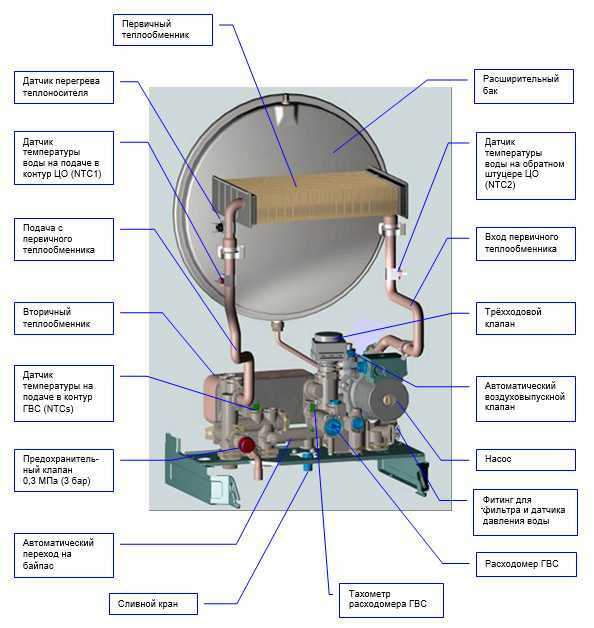
It is very important to monitor the pressure, temperature of the coolant, to respond to any unusual for normal operation heating system signs - knocking, frequent discharge of hot water through the safety valve, cold sections of the circuit
The head in a closed circuit occurs due to forced circulation carried out by a pump. Abnormal pressure can lead to equipment failure.
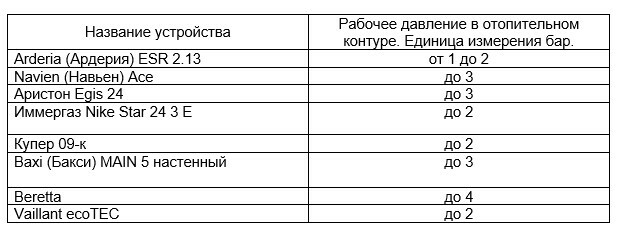
The nominal pressure in gas boilers of various models may vary, it is determined by the technical characteristics of the equipment
When designing a heating system, the pressure is calculated taking into account the height of the water column, the length of the system, the characteristics of the connected equipment, and the cross-section of the pipes.
To adjust working pressure you need to focus on the following parameters:
- Technical characteristics of a gas boiler. The manufacturer indicates the capabilities of the equipment and its settings in the instructions.
- Heat carrier temperature. The higher the temperature, the greater the pressure in the circuit; as it decreases, it decreases. Therefore, the adjustment and measurement of pressure in the gas boiler and the heating circuit must be carried out before and after heating the coolant.
- The volume of the circuit and expansion tank. The size of the accumulator has a direct effect on the pressure in the heating circuit, on the range of its fluctuations.
- Allowable pressure readings for the least "weak" element "of the system. The pressure in the system should not exceed the permissible values for each of its elements. For example, polypropylene pipes, which, on average, are designed for a pressure of 25 bar at room temperature of the coolant, at a temperature of 90 ° C withstand an increase in pressure only up to 7-9 bar.
The minimum pressure in the circuit can be 0.5-0.8 bar, the exact standard values are indicated in the instructions, in accordance with them the pressure sensor is adjusted to the required value. If the pressure in the heating system drops below 0.5 bar, an emergency situation arises, in which the gas boiler may stop or be damaged.
The highest pressure in the system is up to 3, rarely up to 4 bar. For a five-storey building, pressures are set up to 5 bar, for a ten-storey building up to 7 bar. When making settings, it is necessary to adhere to the difference in pressure between the outgoing and return pipes - it should be 0.3-0.5 bar. After starting the heating, check if this is the case.
How to check the pressure in the boiler and the circuit
Control over the pressure in the system is carried out using instruments that measure and reflect the pressure in the circuit using a digital or mechanical dial. The sensors are installed by the manufacturer on the boiler outlet.
During the installation of the system manometers They are also installed near the collectors that distribute the coolant to various parts or floors of the building.
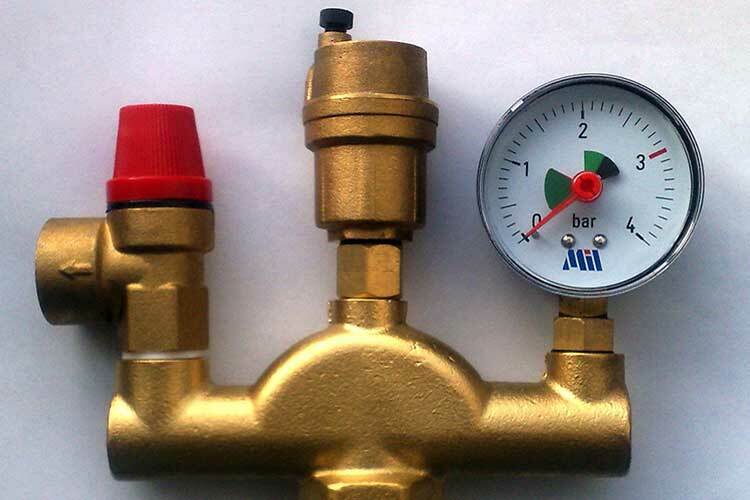
The safety group for boilers in the heating system helps to control the temperature regime, the pressure in the circuit, protects the equipment from destruction, diverting excess pressure outside
Additional pressure control is required when using boilers for heating water, in underfloor heating systems. A drop or increase in pressure can be observed in different ways in different parts of the heating system.

The closed loop allows to increase the pressure in the system, which increases its safety, since at higher pressure the boiling point of the liquid increases
When starting the gas boiler, check the pressure gauge while the heating water is still cold - the pressure must not be lower than the minimum value indicated by the red adjustable arrow pressure gauge. The setting is carried out by a representative of the company with which a contract for service and gas supply has been concluded.
The initial setting is made when the heating is started for the first time. In the future, the pressure is checked every week, if necessary, the system is fed with water. Make-up is carried out at a coolant temperature below 40 ° C.
Reasons for an increase in pressure in a gas boiler
To detect an increase in pressure in a gas boiler, in addition to the pressure gauge readings, frequent discharge of water through the safety valve and blocking of the device help. Having determined high pressure, first of all, they release excess air through Mayevsky cranes and turn off the boiler. There can be several reasons for malfunctions.

The normal upper pressure value is provided by the system by dumping the excess coolant through the safety valve into the drain
An increase in the pressure in the gas boiler can result in damage to the partition of the secondary heat exchanger, which serves simultaneously to isolate and increase the contact area of two circuits - heating and hot water supply.
The secondary heat exchanger draws water from the heating circuit for the preparation and supply of DHW to double-circuit boiler. Damage to the partition leads to the pushing of water from the DHW circuit into the heating system, increasing the pressure in it.
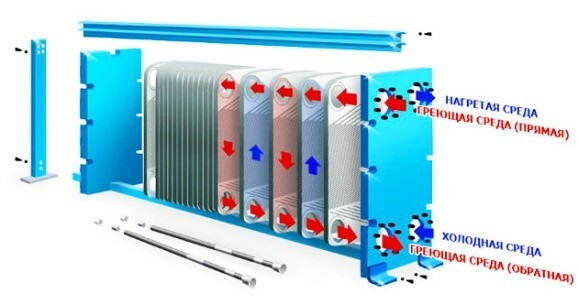
The secondary heat exchanger serves to service the hot water supply system. The DHW water heats up as a result of contact with the heating medium in the heating circuit. A metal baffle protects the system from mixing the two circuits, damage to which leads to the exchange of fluids and disruption of normal pressure
Replacing the heat exchanger will solve the problem. It is possible to carry out repairs on your own, but it is undesirable to do this, since interfering with the operation of gas equipment requires knowledge and experience in this area. In addition, self-repair of the boiler will deprive you of the right to warranty service.
Failure in work gas boiler automation or a loose pump impeller that sucks in air also increases the pressure in the gas boiler. Equipment malfunctions that lead to abnormalities in the normal pressure may be the result of a factory defect, a breakdown of the control board, or an incorrectly configured system. Only a qualified technician can fix this kind of problem.
Increasing the pressure in the heating circuit
What to do if the pressure in the heating system rises excessively?
First of all, you need to establish the reason, and there may be several of them:
- Incorrect filling of the circuit, its airing. Due to the rapid filling of the heating line, air locks can form in it. To avoid this phenomenon, fill it slowly when starting the heating.
- The temperature in the circuit is too high. Any increase in temperature and coolant leads to its expansion and an increase in pressure in the system. It is necessary not to allow too much increase in order to protect the heating equipment from critical loads.
- Stopping the movement of the coolant. The reason may be a closed shut-off valve, blockage of the mud filter, air plugs.
To identify the problem area, it is necessary to examine the entire contour step by step.
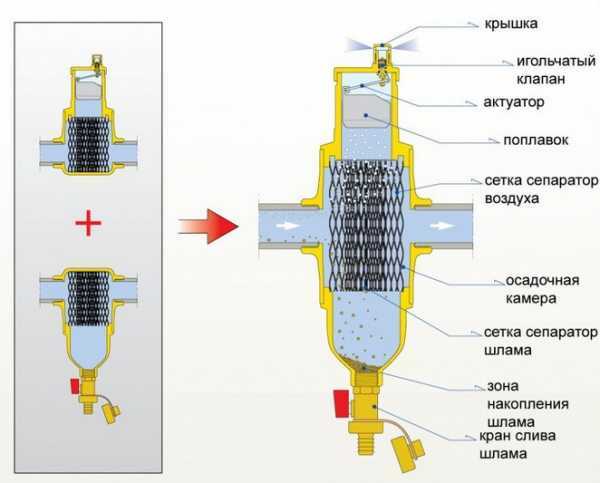
It is necessary to check and clean the filter immediately after the first start of the boiler, and then again after a week. Further, routine checks and cleaning are carried out once a month or season, depending on the degree of contamination of the coolant
Leaks can be caused by a breakdown of the make-up valve - wear of the valve gasket, mechanical damage to parts, scale trapped between the seat and the gasket. If the tap passes, then the excess water coming from the water supply system to the heating main increases the pressure in it, because the pressure in the cold water supply is always higher. It is necessary to tighten the tap or replace it if it fails.
Air locks are a common cause of heating system problems. They can be caused both by malfunctions of the gas boiler itself, as well as problems in the circuit or improper start of heating.
Restarting the system will help troubleshoot the problem - its slow filling with coolantstarting from the lowest point until water flows from the top of the contour. At the same time, all air bleed valves must be open. Airing the system can lead to both an increase and a decrease in pressure.
The main reasons for the decrease in pressure
Common reasons why the pressure in a gas heating boiler drops are:
- Coolant leak. Damage to the heating main leads to a leakage, loss of heating water and a decrease in pressure.
- Cracks in the heat exchanger. Leaks in the boiler itself will not only lead to a decrease in pressure, but can also provoke more serious equipment breakdowns, damage the electronics.
- Diaphragm rupture in expansion tank. Through damage in the rubber baffle, the liquid enters the air compartment and the pressure in the circuit is reduced.
To determine the place of a leak in the system, it is fed to normal pressure and the operation of the circulation pump is stopped. Step by step it is necessary to inspect the highway, identify the problem area and troubleshoot.
How does the operation of a hydraulic accumulator affect pressure
Expansion vessel problems that affect the head in the heating circuit are very common. Incorrectly calculated volume of expansomat is one of the most characteristic prerequisites.
Malfunctions can result from improper installation, low or high pressure in the air chamber. tank, damaged membrane - each of the reasons can lead to a disruption in the circulation of the coolant in system.
Expansion tank: device features and volume
If a small tank is installed in the heating system, it cannot compensate for the expansion of the heating water during heating. At a temperature of 85-95 ° C, the water expands by about 4% and its excess volume exits through safety relief valve.
In order for the expansomat to fully perform its compensatory function, its capacity for systems with a gas boiler must be at least 10 percent of the total volume of water in the circuit.
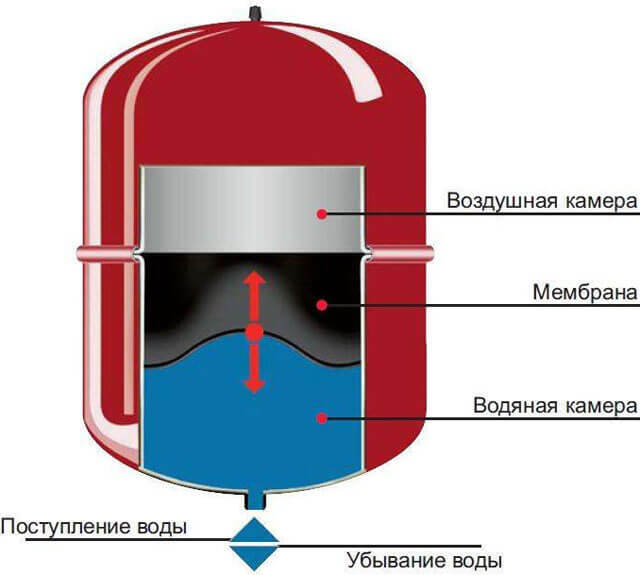
If you install a tank with a volume of more than normal, then the pressure fluctuations will be even less. Reducing pressure drops has a positive effect on the operation of the system and the service life of heating equipment
Damage to the tank membrane leads to the fact that water completely fills its volume and the pressure in the circuit drops. If you fill the volume of the circuit by opening the make-up valve, this will create a new problem - when the coolant heats up, it will not have much to expand and the pressure in the system will increase more than normal. The situation can be corrected only by replacing the rubber partition.
The tank should be installed only on the return pipe, in front of the heating boiler. So the tank will have a minimal effect on the operation of the circulation pump, which is installed after the gas boiler. In addition, here the water temperature is lower and the negative effect on the pressure in the system and on the tank membrane will be less.
Air chamber pressure setting
The pressure formed in the air chamber of the expansomat can also lead to an increase or decrease in the pressure inside the heating system. It is possible to check and pump air in the tank only if there is no coolant in the tank.
To do this, shut off access to the common circuit with shut-off valves and drain the water through the drainage drain. Then the pressure in the air chamber is measured and inflated / deflated to the required values.
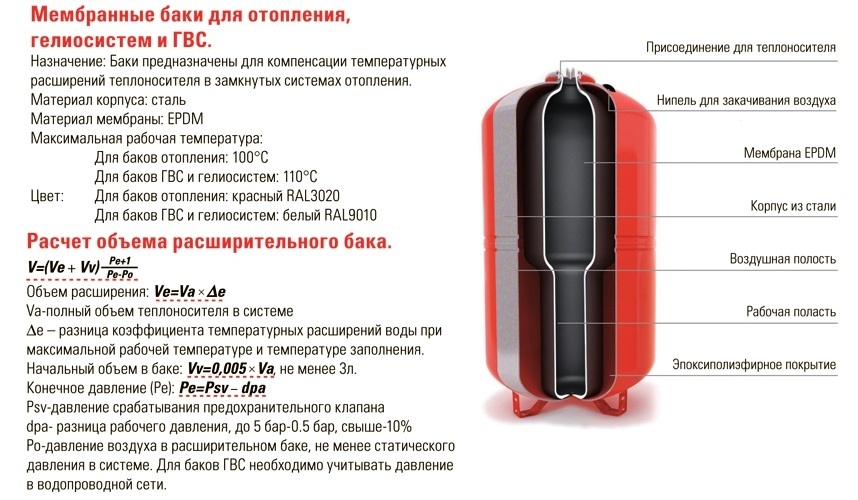
You can check the pressure indicators in the expansion tank using a car pressure gauge, pump it up using a car pump
For settings expansion tank pressure the air chamber must be 0.5 bar higher than the expected maximum system pressure. After the pressure in the equalizing part of the tank is adjusted, the circuit is filled with cold water to the expected pressure.
Then the air from the air chamber is lowered until the pressure in the heating circuit and tank starts decrease simultaneously - here it is necessary to simultaneously monitor the pressure in the system and in the expansion tank.
In this phase, changes in indicators are hardly noticeable, therefore, it is necessary to be ready to immediately stop bleeding air from the expansion tank as soon as a simultaneous decrease is detected.
Conclusions and useful video on the topic
Pressure surges in a heating system with a double-circuit boiler:
Why does the pressure drop in the heating system:
The reasons for the increase in pressure in the heating circuit:
The instability of the pressure in the heating system arises due to its incorrect connection, non-observance of operating rules, the use of faulty devices.
Understanding the reasons for the drop and increase in pressure in a gas boiler helps to properly maintain the system, but this is not a reason to independently interfere with the operation of the equipment. For help, it is better to contact a master from the gas service supplying blue fuel.
And what problems with a drop or increase in pressure have arisen during the operation of your gas boiler? Share the methods that you used to bring the pressure to the norm. Please leave comments in the form below, here you can ask questions and post a photo on the topic of the article.


